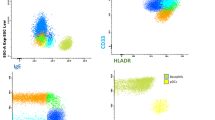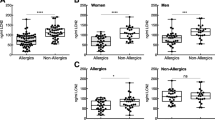Abstract
Background
The importance of dendritic cells (DCs) in the initiation of the Th2-mediated inflammatory response to allergens is well known and more recently it has been proposed that DCs have a pivotal role in maintaining tolerance to allergens. The aim of this study was to investigate whether the success of sublingual immunotherapy (SLIT) in allergic asthma is mediated by the induction of changes of DCs functions.
Methods
Ten children with allergic asthma sensitive to house dust mite were studied before and after 12 months of SLIT. Immature DCs were derived from peripheral blood monocytes cultured for 6 days in presence of interleukin (IL)-4 and GM-CSF and stimulated with lipopolysaccharide for the last 24 hours to induce maturation.
Results
After 12 months of SLIT, mature DCs derived from SLIT-treated patients showed a statistically significant defect of CD86 up-regulation, an increase of IL-10, and a reduction of IL-12 production.
Conclusion
SLIT induces changes in DCs functions that might be responsible for an impairment of T cell activation or drive T cells towards a regulatory activity, thus restoring immune tolerance to allergens.
Similar content being viewed by others
References
Bousquet J, Lockey R, Malling HJ. Allergen immunotherapy: therapeutic vaccines for allergic diseases. A WHO position paper. J Allergy Clin Immunol 1998;102:558–562.
Akdis CA, Akdis M. Mechanisms and treatment of allergic disease in the big picture of regulatory T cells. J Allergy Clin Immunol 2009;123:735–746; quiz 747–748.
Akdis M, Verhagen J, Taylor A, Karamloo F, Karagiannidis C, Crameri R, et al. Immune responses in healthy and allergic individuals are characterized by a fine balance between allergen-specific T regulatory 1 and T helper 2 cells. J Exp Med 2004;199:1567–1575.
Ozdemir C, Akdis M, Akdis CA. T regulatory cells and their counterparts: masters of immune regulation. Clin Exp Allergy 2009;39:626–639.
Francis JN, Till SJ, Durham SR. Induction of IL-10+CD4+CD25+ T cells by grass pollen immunotherapy. J Allergy Clin Immunol 2003;111:1255–1261.
Gardner LM, Thien FC, Douglass JA, Rolland JM, O’Hehir RE. Induction of T ‘regulatory’ cells by standardized house dust mite immunotherapy: an increase in CD4+ CD25+ interleukin-10+ T cells expressing peripheral tissue trafficking markers. Clin Exp Allergy 2004;34:1209–1219.
Jutel M, Akdis CA. T-cell regulatory mechanisms in specific immunotherapy. Chem Immunol Allergy 2008;94:158–177.
Jonuleit H, Schmitt E, Schuler G, Knop J, Enk AH. Induction of interleukin 10-producing, nonproliferating CD4(+) T cells with regulatory properties by repetitive stimulation with allogeneic immature human dendritic cells. J Exp Med 2000;192:1213–1222.
Nguyen KD, Vanichsarn C, Nadeau KC. Impaired IL-10-dependent induction of tolerogenic dendritic cells by CD4+CD25hiCD127lo/- natural regulatory T cells in human allergic asthma. Am J Respir Crit Care Med 2009;180:823–833.
Rutella S, Danese S, Leone G. Tolerogenic dendritic cells: cytokine modulation comes of age. Blood 2006;108:1435–1440.
Roncarolo MG, Gregori S, Battaglia M, Bacchetta R, Fleischhauer K, Levings MK. Fleischhauer K, Levings MK. Interleukin-10-secreting type 1 regulatory T cells in rodents and humans. Immunol Rev 2006;212:28–50.
Bousquet J, Scheinmann P, Guinnepain MT, Perrin-Fayolle M, Sauvaget J, Tonnel AB, et al. Sublingual-swallow immunotherapy (SLIT) in patients with asthma due to housedust mites: a double-blind, placebo-controlled study. Allergy 1999;54:249–260.
La Rosa M, Ranno C, André C, Carat F, Tosca MA, Canonica GW. Double-blind placebo-controlled evaluation of sublingual-swallow immunotherapy with standardized Parietaria judaica extract in children with allergic rhinoconjunctivitis. J Allergy Clin Immunol 1999;104:425–432.
Bousquet J, Demoly P. Specific immunotherapy—an optimistic future. Allergy 2006;61:1155–1158.
Wilson DR, Lima MT, Durham SR. Sublingual immunotherapy for allergic rhinitis: systematic review and meta-analysis. Allergy 2005;60:4–12.
Moingeon P, Batard T, Fadel R, Frati F, Sieber J, Van Overtvelt L. Immune mechanisms of allergen-specific sublingual immunotherapy. Allergy 2006;61:151–165.
Bohle B, Kinaciyan T, Gerstmayr M, Radakovics A, Jahn-Schmid B, Ebner C. Sublingual immunotherapy induces IL-10-producing T regulatory cells, allergen-specific T-cell tolerance, and immune deviation. J Allergy Clin Immunol 2007;120:707–713.
O’Hehir RE, Gardner LM, de Leon MP, Hales BJ, Biondo M, Douglass JA, et al. House dust mite sublingual immunotherapy: the role for transforming growth factor-beta and functional regulatory T cells. Am J Respir Crit Care Med 2009;180:936–947.
Demoly P, Allaert FA, Lecasble M, Bousquet J; PRAGMA. Validation of the classification of ARIA (allergic rhinitis and its impact on asthma). Allergy 2003;58:672–675.
LeBlanc A, Robichaud P, Lacasse Y, Boulet LP. Quantification of asthma control: validation of the Asthma Control Scoring System. Allergy 2007;62:120–125.
Tsuyuki S, Tsuyuki J, Einsle K, Kopf M, Coyle AJ. Costimulation through B7-2 (CD86) is required for the induction of a lung mucosal T helper cell 2 (TH2) immune response and altered airway responsiveness. J Exp Med 1997;185:1671–1679.
Larché M, Till SJ, Haselden BM, North J, Barkans J, Corrigan CJ, et al. Costimulation through CD86 is involved in airway antigen-presenting cell and T cell responses to allergen in atopic asthmatics. J Immunol 1998;161:6375–6382.
Haczku A, Takeda K, Redai I, Hamelmann E, Cieslewicz G, Joetham A, et al. Anti-CD86 (B7.2) treatment abolishes allergic airway hyperresponsiveness in mice. Am J Respir Crit Care Med 1999;159:1638–1643.
Pereira C, Tavares B, Loureiro G, Paiva A, Henriques A, Abrantes M, et al. Dynamics of CD86 expression on allergic inflammation—new insights. Recent Pat Inflamm Allergy Drug Discov 2009;3:128–131.
Creery WD, Diaz-Mitoma F, Filion L, Kumar A. Differential modulation of B7-1 and B7-2 isoform expression on human monocytes by cytokines which influence the development of T helper cell phenotype. Eur J Immunol 1996;26:1273–1277.
Steinbrink K, Jonuleit H, Müller G, Schuler G, Knop J, Enk AH. Interleukin-10-treated human dendritic cells induce a melanoma-antigen-specific anergy in CD8(+) T cells resulting in a failure to lyse tumor cells. Blood 1999;93:1634–1642.
Sato K, Yamashita N, Matsuyama T. Human peripheral blood monocyte-derived interleukin-10-induced semi-mature dendritic cells induce anergic CD4(+) and CD8(+) T cells via presentation of the internalized soluble antigen and cross-presentation of the phagocytosed necrotic cellular fragments. Cell Immunol 2002;215:186–194.
Romagnani S. Biology of human TH1 and TH2 cells. J Clin Immunol 1995;15:121–129.
Ciprandi G, Fenoglio D, Cirillo I, Vizzaccaro A, Ferrera A, Tosca MA, et al. Induction of interleukin 10 by sublingual immunotherapy for house dust mites: a preliminary report. Ann Allergy Asthma Immunol 2005;95:38–44.
Savolainen J, Jacobsen L, Valovirta E. Sublingual immunotherapy in children modulates allergen-induced in vitro expression of cytokine mRNA in PBMC. Allergy 2006;61:1184–1190.
Cosmi L, Santarlasci V, Angeli R, Liotta F, Maggi L, Frosali F, et al. Sublingual immunotherapy with Dermatophagoides monomeric allergoid down-regulates allergen-specific immunoglobulin E and increases both interferon-gamma- and interleukin-10-production. Clin Exp Allergy 2006;36:261–272.
Tsai YG, Chiou YL, Chien JW, Wu HP, Lin CY. Induction of IL-10+ CD4+ CD25+ regulatory T cells with decreased NFkappaB expression during immunotherapy. Pediatr Allergy Immunol 2010;21:e166–e173.
Savolainen J, Laaksonen K, Rantio-Lehtimäki A, Terho EO. Increased expression of allergen-induced in vitro interleukin-10 and interleukin-18 mRNA in peripheral blood mononuclear cells of allergic rhinitis patients after specific immunotherapy. Clin Exp Allergy 2004;34:413–419.
Ciprandi G, Cirillo I, Fenoglio D, Marseglia G, Tosca MA. Sublingual immunotherapy induces spirometric improvement associated with IL-10 production: preliminary reports. Int Immunopharmacol 2006;6:1370–1373.
Steinbrink K, Graulich E, Kubsch S, Knop J, Enk AH. CD4(+) and CD8(+) anergic T cells induced by interleukin-10-treated human dendritic cells display antigen-specific suppressor activity. Blood 2002;99:2468–2476.
Sato K, Yamashita N, Baba M, Matsuyama T. Modified myeloid dendritic cells act as regulatory dendritic cells to induce anergic and regulatory T cells. Blood 2003;101:3581–3589.
Wakkach A, Fournier N, Brun V, Breittmayer JP, Cottrez F, Groux H. Characterization of dendritic cells that induce tolerance and T regulatory 1 cell differentiation in vivo. Immunity 2003;18:605–617.
Koya T, Matsuda H, Takeda K, Matsubara S, Miyahara N, Balhorn A, et al. IL-10-treated dendritic cells decrease airway hyperresponsiveness and airway inflammation in mice. J Allergy Clin Immunol 2007;119:1241–1250.
Author information
Authors and Affiliations
Corresponding author
Rights and permissions
About this article
Cite this article
Angelini, F., Pacciani, V., Corrente, S. et al. Dendritic cells modifi cation during sublingual immunotherapy in children with allergic symptoms to house dust mites. World J Pediatr 7, 24–30 (2011). https://doi.org/10.1007/s12519-011-0242-3
Received:
Accepted:
Published:
Issue Date:
DOI: https://doi.org/10.1007/s12519-011-0242-3




